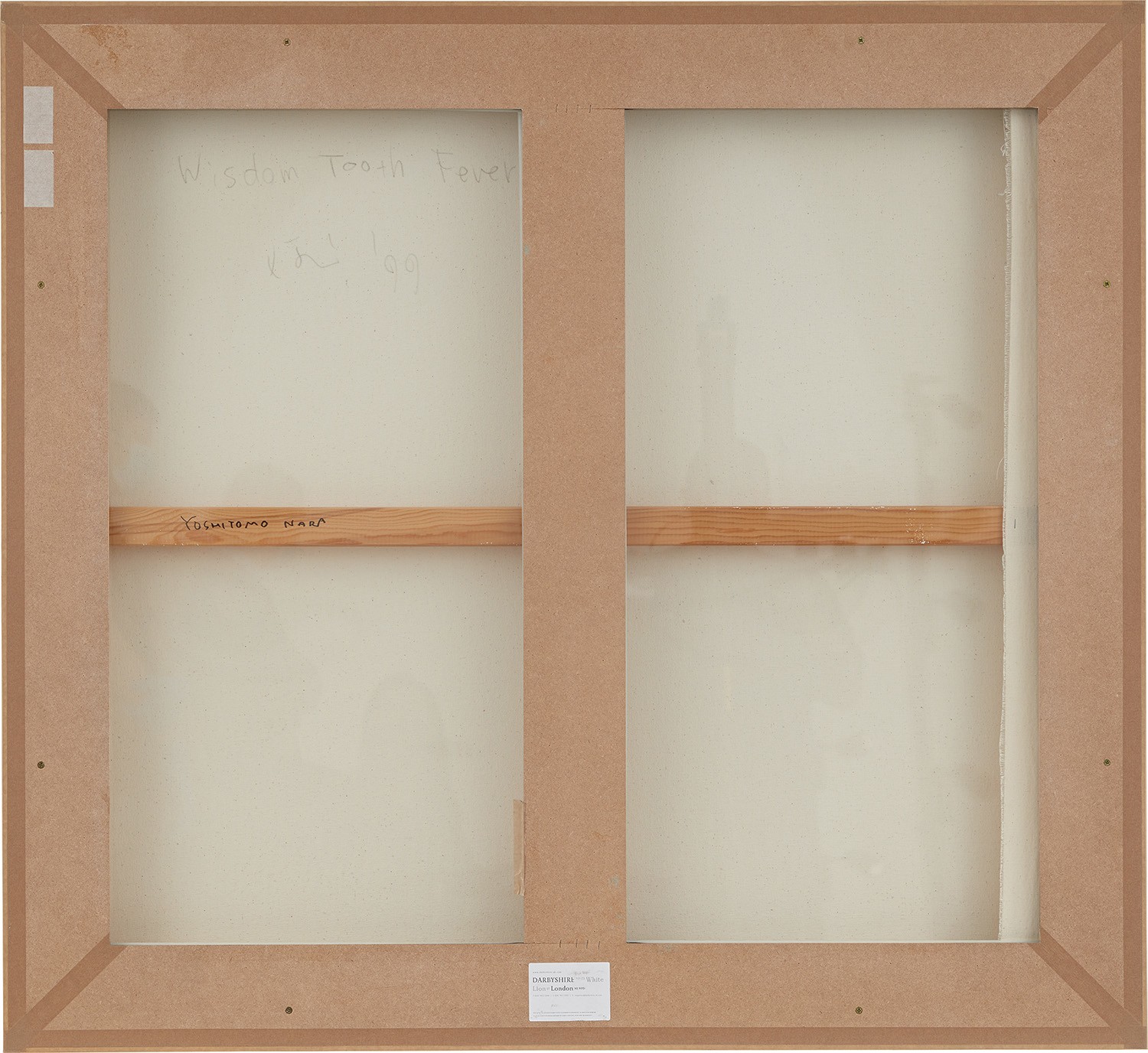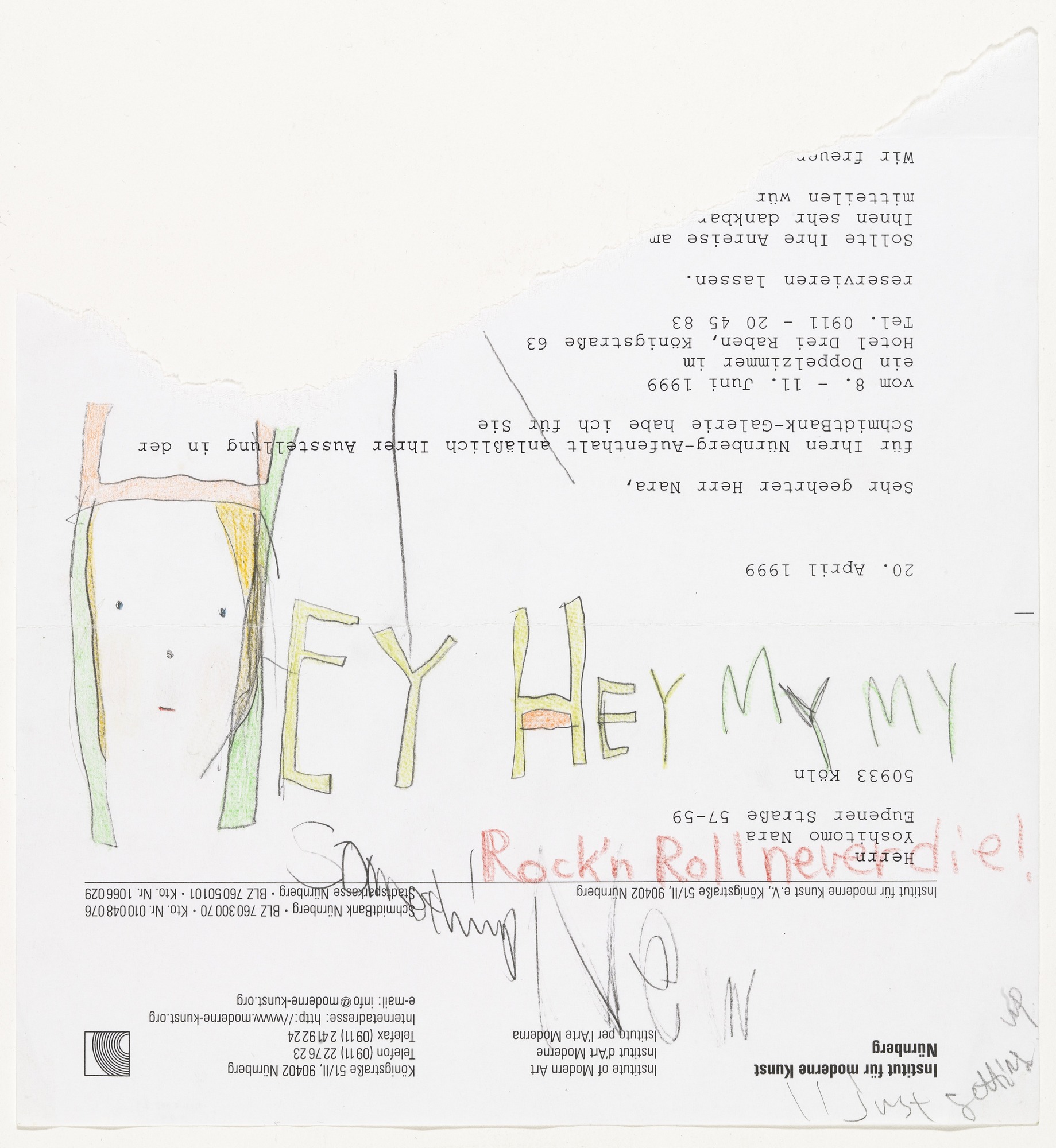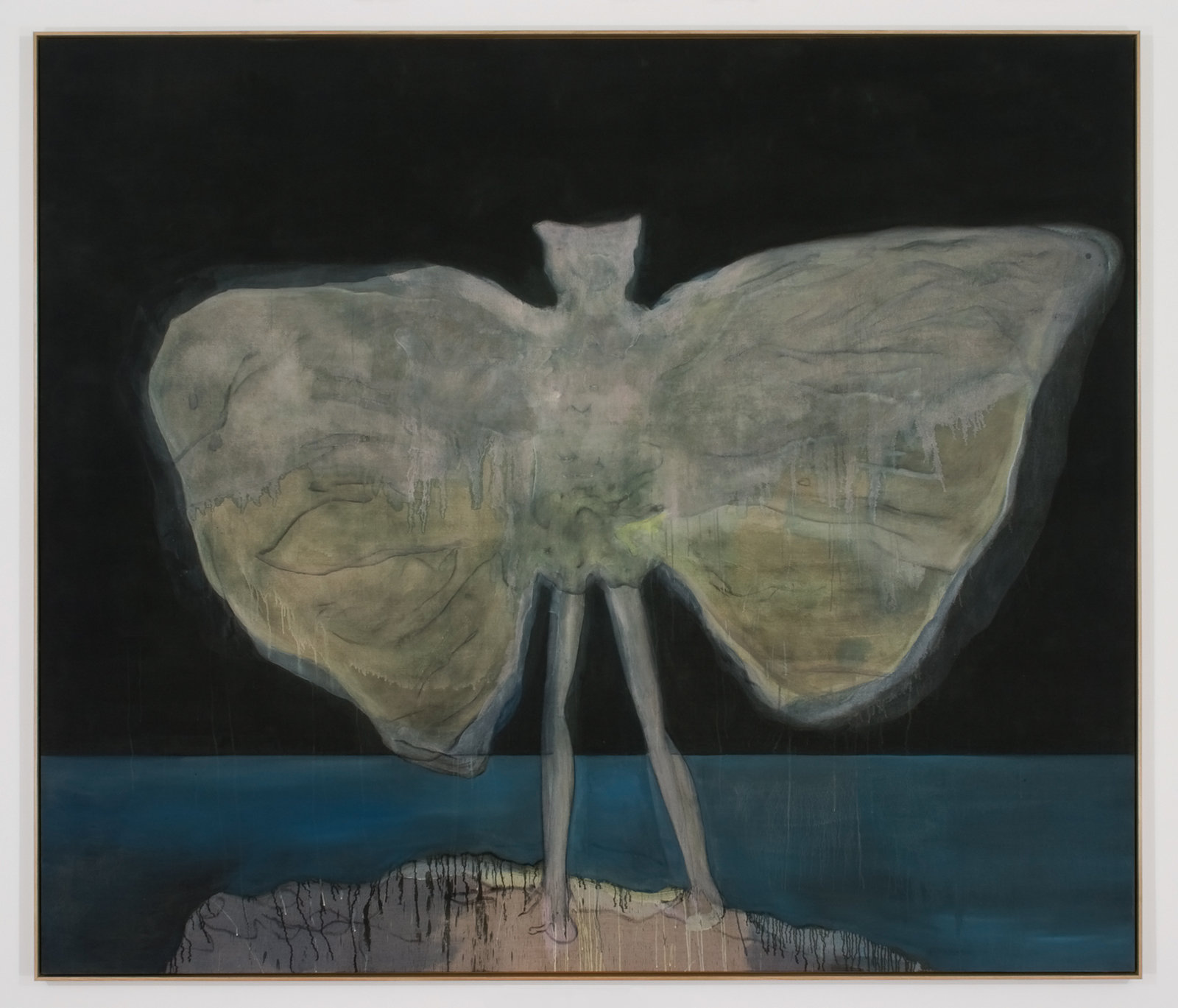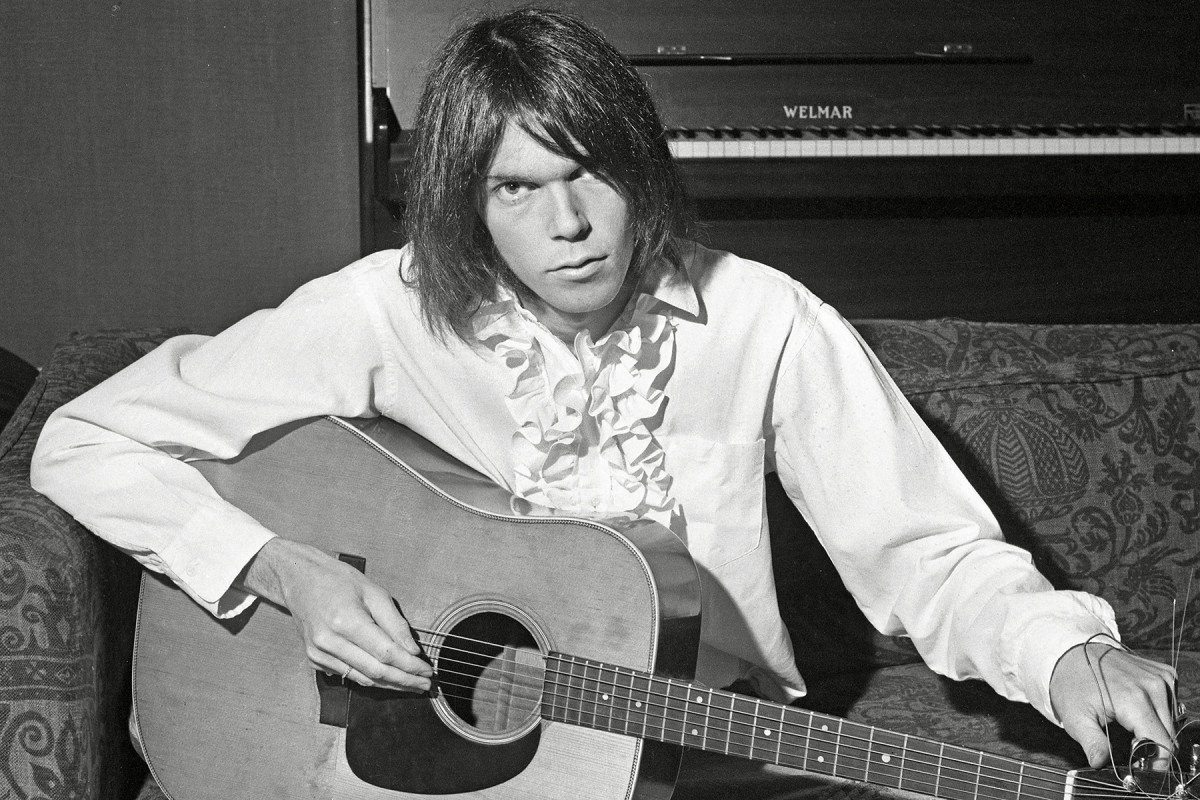



Property from a Distinguished Private European Collection
14✱
Yoshitomo Nara
Wisdom Tooth Fever
signed, titled and dated '"Wisdom Tooth Fever" Nara [in Japanese] '99' on the reverse
acrylic on canvas
110 x 120.2 cm (43 1/4 x 47 3/8 in.)
Painted in 1999.
Full-Cataloguing

Yoshitomo Nara
Untitled ("Hey Hey My My Rock'n Roll Never Die!")
1992–2000
Collection of Museum of Modern Art, New YorkThe iconic works of cult artist Yoshitomo Nara, one of the leaders of Japan’s influential Neo Pop movement, reflect the experiences of a generation of artists who grew up during the post-World War II economic boom in Japan. Nara’s works are characterised by a search for identity amidst an influx of popular culture from the West, fusing Japanese visual traditions and Western popular culture to create adorable yet complex characters possessing a startling emotional intensity. Today Nara’s characters are as instantly recognisable as Warhol’s screenprinted portraits and Lichtenstein’s Benday-dotted heroines.
Childhood revisited
Nara was born in Hirosaki, a small town in rural Japan best known for its traditional Edo Period architecture and cherry blossom trees. The youngest child of working parents, he experienced an intensely lonely childhood with only his imagination, comic books and family pets for company: ‘I was lonely, and music and animals were a comfort’, he admitted. ‘I could communicate better with animals, without words, than communicating verbally with humans’ (Yoshitomo Nara, quoted in Gareth Harris, ‘Interview: Japanese artist Yoshitomo Nara’, Financial Times, 10 October 2014, online).
Upon graduating from the Aichi University of the Arts, Nara moved to Germany to undertake a six-year artistic apprenticeship at Düsseldorf’s Staatliche Kunstakademie under the mentorship of the Neo-Expressionist painter A.R. Penck, before setting up a studio in Köln between 1994 and 2000. Language barriers in Germany plunged Nara back into a period of acute solitude not experienced since his childhood. Seeking relief, Nara began plumbing the depths of his subconscious through his art, his profound sense of alienation during his years in Germany manifesting itself in his iconic sulky-child portraits. Wide-eyed and innocent at first glance, these kowa kawaii (‘scary cute’) little children were depicted in poses reminiscent of the anime and manga cartoons Nara read as a child, yet each underpinned by a sense of tension and unease evocative of traditional Japanese otafuku and okame theatrical masks. Beneath their luminous, almost comical faces lies a spirit of mutinous, childlike defiance; at other moments they betray a distinctly adolescent melancholy. Nara would remember this heightened period of introspection as formative, restoring to him a ‘sense of [his] true self’ that he had almost forgotten (Nara, quoted in Nara Yoshitomo: A Bit Like You and Me, exh. cat., Yokohama Museum of Art, Japan, 2012, p. 129).
Growing pains: Wisdom Tooth Fever

Peter Doig
Man Dressed As Bat (Night) , 2008
Wisdom Tooth Fever, amongst the rarest works on canvas by Nara to come to auction, is one of the most accomplished examples of the artist's distinctive lyrical and abbreviated figurative language forged in those crucial years in Germany. Wisdom Tooth Fever was exhibited as part of the 1999 Nuremberg Kunsthalle group show ‘Forget the ball and keep playing - the image of the child in contemporary art’, featuring artistic reflections on children and childhood from 15 international artists including Julian Opie, Paul McCarthy and Martin Kippenberger. The concept of childhood, with its contradictory ideas of utopian purity and lost paradise, of growing pains and redemptive hopes and dreams, functions as a near-mythical space somewhere between fiction and reality. Nara explained at the time that Wisdom Tooth Fever meditated on the idea of childhood pain, where the pain becomes all-encompassing and displaces all other thoughts: ‘pain is everything - no other outer world or surrounding’, the work’s collector recalls Nara explaining of its subject. In Nara’s touching portrait of childhood the face of a young child crowds the vast canvas, the faintest traces of a furrow between the squinted jellybean eyes and lips pursed mid-thought as he peers out. The emotional, dream-like mood is intensified by the subtle layering of thin, semi-translucent paint layers, a technique reminiscent of the acclaimed painter Peter Doig, who later became an influential tutor at the Kunstakademie Düsseldorf.
Like his tutor A.R. Penck, Nara created ‘worlds’ and ‘experience spaces’ filled with symbolic abbreviations informed by his inner life, with works such as Yr. Childhood (1995) and This is how to become an adult (1995-96) embodying deeply personal connections, associations and memories (the former a portrait of a child helplessly stuck in a deep puddle, and the latter a depiction of a toothache-ridden child suffering performing an self-extraction). Nara denies such high-brow intentions, insisting: ‘I don't think too hard about it. This is just what comes out.’ (David McNeill, ‘Yoshitomo Nara: neo-pop artist who defies categorisation’, South China Morning Post Magazine, 4 March 2015, online). Yet it is this profound, intuitive understanding of human emotion that has won Nara followers beyond all cultural and language barriers. ‘He seems never to have met a culture or generation gap, a divide between art mediums or modes of consumption that he couldn't bridge or simply ignore,’ explained the eminent art critic Roberta Smith. His art fuses ‘high, low and kitsch; East and West; grown-up, adolescent and infantile’, and is ‘so seamless as to render such distinctions almost moot’ (Roberta Smith, ‘Cuddling With Little Girls, Dogs and Music’, The New York Times, 9 September 2010, online).
‘Rock'n Roll Never Die!’

American singer, Neil Young
Photo by Dick Barnatt/Redferns/Getty Images
Using each of his works to deliver an uplifting message of universal connection and hope, Nara has looked to his love of music to reinforce his artistic practice. A vital source of inspiration from childhood, Nara explained: ‘There was no museum where I grew up so my exposure to art came from the album covers’ (Yoshitomo Nara, quoted in Gareth Harris, ‘Interview: Japanese artist Yoshitomo Nara’, Financial Times, 10 October 2014, online). When asked to name a person of great importance to him, Nara chose a musician - ‘Neil Young. He is my all-time favourite’ (Yoshitomo Nara, quoted in Aimee Lin, ‘Yoshitomo Nara’, ArtReview Asia, October 2015, online). Perhaps unsurprisingly, the young subject of Wisdom Tooth Fever bears the distinctive features of the legendary singer-songwriter and activist, who famously wrote three of his best-known songs in one day whilst sick with a fever. Nara has also paid homage to his hero Neil Young in a number of his other works, for example It’s Better to Burn Out than Fade Away (1996), and Untitled ("Hey Hey My My Rock'n Roll Never Die!") (1992-2000) referencing Young’s 1977 anthem My, My, Hey, Hey (Out of the Blue). In 2020 the Los Angeles County Museum of Art holds a major retrospective covering 30 years of Nara’s career through the lens of his longtime passion, music.